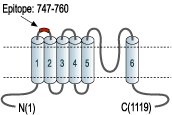Overview
- Peptide (C)NSTGIINETSDHSE, corresponding to amino acid residues 747-760 of human TRPA1 (Accession O75762). 1st extracellular loop.

 Cell surface detection of TRPA1 by direct flow cytometry in live intact mouse J774 macrophage cells:___ Cells.
Cell surface detection of TRPA1 by direct flow cytometry in live intact mouse J774 macrophage cells:___ Cells.
___ Cells + Rabbit IgG isotype control-FITC.
___ Cells + Anti-TRPA1 (extracellular)-FITC Antibody (#ACC-037-F), (2.5µg). Cell surface detection of TRPA1 by direct flow cytometry in live
Cell surface detection of TRPA1 by direct flow cytometry in live
intact human MEG-01 megakaryoblastic leukemia cells:___ Cells.
___ Cells + Rabbit IgG isotype control-FITC.
___ Cells + Anti-TRPA1 (extracellular)-FITC Antibody (#ACC-037-F), (5µg). Cell surface detection of TRPA1 by direct flow cytometry in live intact human Jurkat T-cell leukemia cells:___ Cells.
Cell surface detection of TRPA1 by direct flow cytometry in live intact human Jurkat T-cell leukemia cells:___ Cells.
___ Cells + Rabbit IgG isotype control-FITC.
___ Cells + Anti-TRPA1 (extracellular)-FITC Antibody (#ACC-037-F), (5µg).
- Hill, K. and Schaefer, M. (2007) J. Biol. Chem. 282, 7145.
- Story, G.M. et al. (2003) Cell 112, 819.
- Bandell, M. et al. (2004) Neuron 41, 849.
- Jordt, S.E. et al. (2004) Nature 427, 260.
- Zurborg, S. et al. (2007) Nat. Neurosci. 10, 277.
- Corey, D.P. et al. (2004) Nature 432, 723.
- Sotomayor, M. et al. (2005) Structure 13, 669.
- Clapham, D.E. (2002) Science 295, 2228.
The TRPA family is comprised of only one mammalian member, the TRPA1 (formerly named ANKTM1). TRPA1 is expressed in peripheral sensory neurons, where it is suggested to contribute to the detection of painful stimuli.1
Originally, it was thought that TRPA channels sensed painfully cold temperatures,2 but a more conservative description is that TRPA1 is sensitive to membrane/cytoskeletal perturbations caused by low temperatures3-5 and perhaps stretch.6 In addition, it is sensitive to pungent natural compounds present in cinnamon oil, mustard oil, and wintergreen oil.
TRPA1 is also expressed in hair cells, where its role in sensing mechanical forces is still unclear and controversial.1
TRPA1 has a similar structure to all other TRP ion channels; six transmembrane domains, intracellular N-and C-terminus. However, the N-terminal domain possesses 17 ankyrin repeats that might indicate its potential role as a mechanosensor.6,7
In addition, TRPA1 is expressed in nociceptive neurons expressing TRPV1 and might serve as a marker for polymodal nociceptors.8
Application key:
Species reactivity key:
Anti-TRPA1 (extracellular) Antibody (#ACC-037) is a highly specific antibody directed against an extracellular epitope of the human protein. The antibody can be used in western blot, immunoprecipitation, immunohistochemistry and live cell imaging applications. It has been designed to recognize TRPA1 from mouse, rat, and human samples.
Anti-TRPA1 (extracellular)-FITC Antibody (#ACC-037-F) is directly conjugated to fluorescein isothiocyanate (FITC) fluorophore. This conjugated antibody has been developed to be used in immunofluorescent applications such as direct flow cytometry and live cell imaging.
